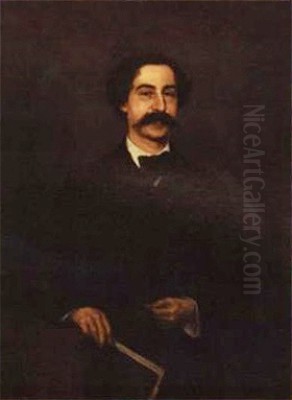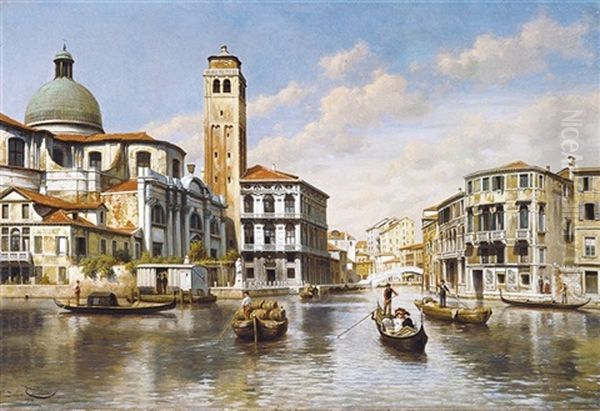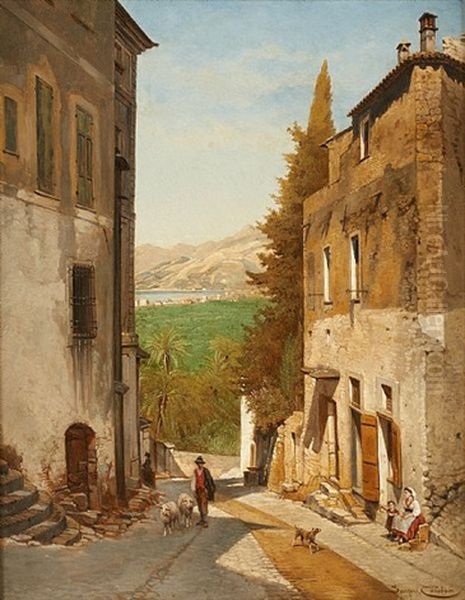
Jacques François Carabain stands as a significant figure in 19th and early 20th-century European art, particularly noted for his detailed and atmospheric depictions of cityscapes. Born Jacob Frans Jozef Carabain in Amsterdam on February 23, 1834, he later adopted the French version of his name, becoming known throughout his long and prolific career as Jacques François Carabain. His life spanned nearly a century, ending in Schaerbeek, Brussels, Belgium, on January 2, 1933. He became a Belgian citizen in 1880, solidifying his connection to the country where he spent much of his adult life and career.
Carabain's artistic output primarily consists of 'vedute' or city views, a genre he mastered with remarkable consistency and detail. He travelled extensively throughout Europe and even ventured as far as Australia and possibly New Zealand, capturing the essence of numerous towns and cities with a keen eye for architectural accuracy and the vibrant life unfolding within them. His work bridges the gap between Romanticism's evocative atmosphere and Realism's dedication to observed detail.
Early Life and Artistic Formation in Amsterdam
Born into the bustling maritime city of Amsterdam, Carabain's initial artistic inclinations were nurtured in his home country. He enrolled at the Amsterdam Academy of Fine Arts (Amsterdamsche Kunstacademie), where he received formal training. His principal teachers were Jacobus Schoemaker Doyer (1792–1867), a painter known for his historical scenes and portraits, and Valentijn Bing (1812–1895), an artist recognized for his genre scenes and decorative work. This education provided him with a solid foundation in drawing, composition, and painting techniques.
Even in his early years, Carabain showed a preference for landscape and architectural subjects. He began exhibiting his work in the Netherlands as early as 1852, participating in the 'Exhibitions of Living Masters' (Tentoonstelling van Levende Meesters) held periodically in Amsterdam, The Hague, and Rotterdam. These early showings helped establish his reputation within the Dutch art scene. His works from this period often depicted Dutch towns and landscapes, rendered with the careful precision that would become a hallmark of his style. In 1855, he married Helena Theodora Ricken, marking a significant personal milestone before his professional life took a decisive turn towards Belgium.
A New Beginning in Brussels

Around 1856, Carabain and his wife relocated to Brussels, the vibrant capital of the relatively young nation of Belgium. This move proved pivotal for his career. Brussels, undergoing significant urban transformation and cultural growth, offered a dynamic environment for an artist specializing in cityscapes. He quickly integrated into the Belgian art world, eventually becoming a naturalized Belgian citizen in 1880. He settled in Schaerbeek, a municipality of Brussels that was becoming a popular residential area for artists.
In Belgium, Carabain continued to refine his distinctive style. He became particularly known for his paintings of Belgian cities like Brussels and Bruges, capturing their historic squares, intricate Gothic and Baroque architecture, and lively market scenes. His approach combined topographical accuracy with a romantic sensibility, often bathing his scenes in warm, inviting light and populating them with small figures that added scale and narrative interest. He wasn't merely documenting buildings; he was capturing the spirit and atmosphere of the urban environment.
The Painter as Traveller: Documenting Europe's Cities
Carabain's wanderlust was a defining characteristic of his career. He embarked on numerous journeys across the European continent, seeking out picturesque towns and iconic landmarks to paint. Italy held a particular fascination for him, as it did for many artists following the tradition of the Grand Tour. He painted numerous views of Venice, capturing the unique interplay of light, water, and architecture in works like Canal Grande. Rome also featured in his oeuvre, with paintings depicting its ancient ruins and bustling streets, such as Via Romana.
His Italian travels extended beyond the major centres. He painted charming scenes in smaller towns like Olevano Romano, nestled in the hills near Rome, captured in works titled Une vue à Olevano. The town of Domodossola, near the Swiss border, also appeared in his work, for example, in Vue de la place Domodosola. These paintings showcase his ability to find beauty in both the grand and the intimate aspects of Italian urban landscapes. His Italian scenes often emphasize bright sunlight and the textures of aged stone, conveying the distinct character of the Mediterranean world.

Carabain's travels were not limited to Italy. He painted extensively in Germany, particularly along the Rhine and Mosel rivers. Works like Market day at the Mosel, likely depicting Cochem or a similar town, capture the charm of German market squares surrounded by half-timbered houses. France, Austria, and other parts of the Mediterranean coast also provided subjects for his brush. This extensive travel provided him with a vast repertoire of subjects and allowed him to develop a nuanced understanding of different urban environments and architectural styles across Europe. His dedication to travel and observation places him in the lineage of earlier veduta painters like Canaletto and Bernardo Bellotto, though his style reflects the sensibilities of the later 19th century.
Capturing Urban Life: Markets and Architecture
A recurring theme in Carabain's work is the bustling market scene. He seemed particularly drawn to the energy and social interaction of open-air markets, often set against the backdrop of impressive civic or religious architecture. Market Day in Bruges is a prime example, depicting the Grote Markt (Market Square) filled with vendors and shoppers, overshadowed by the imposing Belfry. These compositions are complex, featuring numerous figures engaged in various activities, all rendered with careful attention to detail in clothing and posture.
His fascination extended to the architecture itself. Carabain possessed a remarkable ability to render complex architectural details accurately without sacrificing artistic effect. He paid close attention to the textures of stone, brick, and tile, the play of light and shadow across facades, and the perspective of streets and squares. He favoured historical architecture, particularly Medieval and Baroque styles, which offered rich visual complexity. His paintings often serve as valuable historical records of buildings and cityscapes, some of which may have changed or disappeared over time.
This documentary aspect of his work became explicit in the 1890s. In 1894, the City of Brussels commissioned Carabain to create a series of paintings and watercolours depicting older parts of the city, particularly around the Senne river, before they were demolished or significantly altered by major urban renewal projects inspired by Baron Haussmann's work in Paris. These works, now held by the Brussels City Museum, represent a conscious effort to preserve the visual memory of the city's past, highlighting Carabain's role not just as an artist but also as a historical chronicler.
Journeys Down Under: Carabain in Australia
Perhaps the most unexpected chapter in Carabain's extensive travels was his journey to the antipodes. In the 1880s, he spent time in Australia, primarily in Melbourne, Victoria. This period coincided with Melbourne's "Marvellous Melbourne" era, a time of great prosperity and confidence fueled by the earlier gold rushes. Carabain captured the spirit of this booming colonial city in several significant works.
His most famous Australian painting is likely Melbourne Town Hall and Swanston Street, dated 1889. This large canvas depicts the impressive Renaissance Revival town hall and the wide, bustling thoroughfare of Swanston Street, complete with horse-drawn trams, carriages, and pedestrians. The painting, now in the collection of the National Gallery of Victoria, is celebrated for its detailed rendering of the architecture and its vibrant portrayal of urban life in late 19th-century Melbourne. It reflects the city's pride and ambition during that period.
He also painted other Australian scenes, including views of Sydney and potentially Adelaide, as well as landscapes. A work titled Port of Melbourne suggests he also captured the city's maritime activity. His Australian works are notable for their depiction of the distinct southern light and the unique blend of Victorian-era European architecture set within a new world context. His visit provided Australians with a European perspective on their own rapidly developing cities, rendered with the technical skill honed over decades of painting Europe's historic centres. There is also evidence suggesting he may have visited New Zealand during this period.
Exhibitions, Recognition, and Artistic Context
Throughout his long career, Carabain actively exhibited his work, ensuring its visibility to the public and potential patrons. After his early showings in the Netherlands, he became a regular participant in the Salons of Brussels and other Belgian cities. His international reputation grew through participation in major exhibitions abroad. Notably, he exhibited at the prestigious Paris Salons. From 1891 until the outbreak of World War I in 1914, he consistently showed his work at the Salon de la Société Nationale des Beaux-Arts in Paris.
Interestingly, he also exhibited with the Société des Indépendants in Paris during the same period (1891-1914). This is noteworthy because the Indépendants was known for its avant-garde stance, famously showcasing the pointillist works of Georges Seurat and Paul Signac, as well as other Post-Impressionists like Henri Rousseau. Carabain's presence in these exhibitions alongside radically different artists like Albert Dubois-Pillet highlights the diverse nature of these large Salons, which often included a wide spectrum of styles. It suggests Carabain was confident in his more traditional, detailed approach, even amidst the rise of modernism.
His participation in exhibitions extended beyond Europe, as evidenced by his showing at the Victorian Academy of Art in Melbourne in 1885. His works were acquired by museums, including the aforementioned Brussels City Museum and the National Gallery of Victoria, as well as finding their way into numerous private collections across Europe, America, and Australia. His paintings continue to be sought after in the art market today, frequently appearing at auctions, which attests to their enduring appeal. Works listed in auction catalogues, such as those from the Hôtel Devens sales, often include titles like Venice or Street in a Town in Italy, reflecting the popularity of his European views.
Style, Technique, and Contemporaries
Carabain's style is best characterized as a form of Romantic Realism applied to the cityscape genre. He shared the Realist commitment to accurate observation and detailed representation, particularly concerning architecture and urban settings. However, his work often incorporates Romantic elements, such as an emphasis on atmosphere, the evocative quality of light (especially the warm glow of late afternoon or early morning), and a certain picturesque sensibility in his choice of viewpoint and composition. He generally avoided the social commentary found in the work of some Realists like Gustave Courbet, focusing instead on the visual appeal and daily life of the city.
His technique was meticulous. Working primarily in oil on canvas, but also proficient in watercolour, he employed fine brushwork to render architectural details, textures, and the small figures populating his scenes. His compositions are typically well-balanced, often using strong perspective lines created by streets or canals to draw the viewer into the scene. His use of light is crucial in creating mood and defining form.
Carabain worked during a period of immense artistic change. While he remained largely consistent in his style, he was contemporary with major movements like Impressionism, Post-Impressionism, Symbolism, and the rise of Art Nouveau. His detailed, polished finish contrasts sharply with the broken brushwork and fleeting light effects of Impressionists like Claude Monet or Camille Pissarro, who also painted cityscapes but with a focus on capturing transient moments.
Within Belgium, his contemporaries included artists like the history painter Henri Leys, the elegant society portraitist Alfred Stevens, and later, Symbolists like Fernand Khnopff and the highly individualistic James Ensor. Carabain's focus on traditional cityscapes set him apart from these figures. His closest Belgian contemporary in terms of subject matter might be François Bossuet (1798-1889), another painter known for his meticulous vedute, though Bossuet belonged to an earlier generation.
In the Netherlands, his work can be compared to that of Cornelis Springer (1817-1891), who specialized in highly detailed, often historically evocative Dutch townscapes. While Carabain shared Springer's precision, his extensive travels gave his oeuvre a much broader international scope. He also differed from the dominant Dutch movement of his later career, the Hague School (painters like Jozef Israëls, Anton Mauve, Willem Maris), which focused more on atmospheric landscapes and peasant life.
Internationally, his detailed realism might be loosely compared to academic painters like Jean-Léon Gérôme or William Adolphe Bouguereau in terms of finish, although his subject matter was distinct. His work occupies a specific niche, appealing to audiences who appreciated skillful representation, architectural beauty, and the charm of picturesque urban scenes from across Europe and beyond. While there is mention of him being associated with a "Circle of Robert Byng," this likely refers to a stylistic affinity rather than direct collaboration or membership in a formal group, as Byng was a much earlier English painter. Information regarding specific students or direct followers of Carabain is scarce, suggesting he primarily worked independently rather than running a large teaching studio.
Legacy
Jacques François Carabain left behind a vast body of work that serves as a visual encyclopedia of 19th-century European and Australian cities. His long life and dedication to his craft resulted in hundreds of paintings and watercolours, characterized by their technical skill, architectural accuracy, and appealing atmosphere. He successfully navigated the changing art world of the late 19th and early 20th centuries by remaining true to his own meticulous style, finding a consistent market for his picturesque city views.
His paintings are more than just topographical records; they are carefully constructed images that convey the character and ambiance of the places he depicted. The commission from the City of Brussels highlights his recognized ability to document urban heritage. His works continue to be appreciated by collectors and museum visitors for their detail, charm, and nostalgic evocation of a bygone era. Carabain remains a respected figure within the tradition of European cityscape painting, a tireless traveller whose canvases captured the enduring beauty of urban environments across continents.